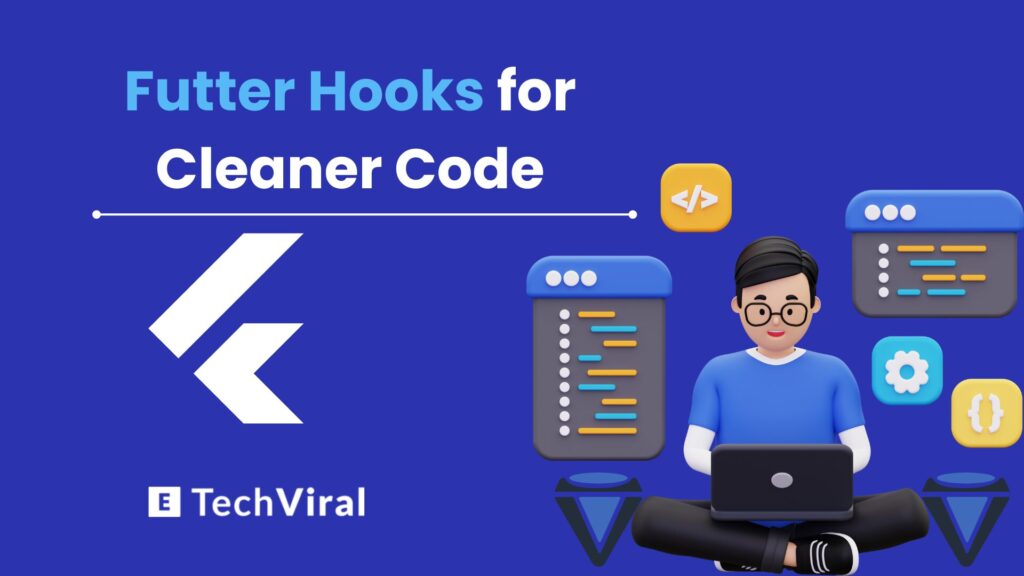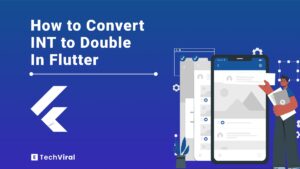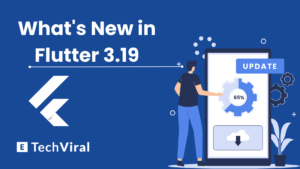Are you tired of your Flutter code looking messy and hard to manage? Flutter Hooks can be your hero! Because many expert developers use flutter hooks for clean code. Imagine writing code that’s not only easy to read but also simple to keep up with.
Flutter Hooks help you organize your code better, making it cleaner and more straightforward. This means less headache when you’re trying to find or fix something. In this article, we’ll dive into how Flutter Hooks can make your coding life much easier, even if you’re not a tech wizard. Let’s simplify coding and make it fun again with Flutter Hooks!
What Are Flutter Hooks?
Flutter Hooks are like little magic spells for your Flutter app. Imagine you have a toolbox, and in it, there’s a special tool that makes your work easier and faster. Flutter Hooks are just that for coding! They help you manage the state and life cycle of your widgets without making a big mess.
In simpler words, when you’re building an app, you have lots of elements on the screen, like buttons, text, or images. These elements can change based on what users do, like tapping a button. Flutter Hooks help you handle these changes smoothly and keep your code clean and easy to understand. There are architectures like Clean architecture and MVVM that also used for clean code to maintain and scale application.
Clean Architecture
Clean Architecture in Flutter is a software design philosophy that emphasizes separation of concerns to achieve a system that is independent of UI, frameworks, and databases. This approach results in a more testable, scalable, and maintainable application structure. By organizing code into distinct layers with clear responsibilities, developers can ensure that their applications are built on a solid and flexible foundation.
Model-View-ViewModel (MVVM)
The Model-View-ViewModel (MVVM) is an architectural pattern designed to separate the graphical interface (the view) from the business logic (the model) via the ViewModel. The ViewModel acts as an intermediary that handles communication between the view and the model, facilitating easier management and testing of UI components. MVVM promotes a clean separation of concerns, enabling developers to build more maintainable and testable applications by dividing responsibilities within the codebase.
How Do Flutter Hooks Work?
Imagine you have a backpack that can magically organize itself. You put in your books, pencils, and snacks, and the backpack arranges them so you can easily find what you need. Flutter Hooks work similarly in your app.
When you use Flutter Hooks, you’re essentially telling your app, “Hey, keep an eye on this piece of information for me, and let me know when it changes.” Hooks take care of the behind-the-scenes work to track changes in your app’s state or data. They do this by using special functions that can “hook into” your app’s state and lifecycle events. This means you can update your app’s look or behavior based on user interactions or other changes without rewriting lots of code.
The Role of Flutter Hooks in State Management
Imagine you’re drawing a picture, and every time you want to change a color, you have to start all over. Sounds frustrating, right? Well, managing the state in apps can sometimes feel like that. But with Flutter Hooks, it’s like having a magic palette where you can change colors easily without starting from scratch.
Flutter Hooks simplify state management in Flutter apps by letting you use special functions to manage the state. This means you can update parts of your app, like changing the text or colors, without redoing everything. It’s like having a smart assistant who remembers all the changes for you and applies them right where they need to go.
With Flutter Hooks, you don’t have to write a lot of complicated code to keep track of these changes. They help you write less code, make it cleaner, and easier to read. This way, you can focus on making your app cool and fun, without getting lost in the code jungle.
How to Implement Flutter Hooks for Clean Code in a project?
Implementing Flutter Hooks in your project is like adding a secret ingredient to your recipe that makes everything taste better. Here’s a simple, step-by-step guide to help you add Flutter Hooks to your Flutter project and make your code cleaner and more manageable.
- Add flutter hooks package
- Import flutter hooks
- Convert your stateless widget to hook widget
- Use a hook in your widget
- Run your app
Step 1: Add Flutter Hooks Package
First, you need to add the flutter_hooks package to your project. Open your pubspec.yaml file and add the following line under dependencies:
flutter_hooks: ^latest_version
Replace latest_version with the latest version of the package available on pub.dev.
Step 2: Import Flutter Hooks
In the Dart file where you want to use Flutter Hooks, import the package at the top:
import 'package:flutter_hooks/flutter_hooks.dart';
Step 3: Convert StatelessWidget to HookWidget
Change your widget from extending StatelessWidget to HookWidget. This allows you to use hooks within your widget.
Before:
class MyWidget extends StatelessWidget {
@override
Widget build(BuildContext context) {
// Your widget code
}
}
After:
class MyWidget extends HookWidget {
@override
Widget build(BuildContext context) {
// Your widget code with hooks
}
}
Step 4: Use Hooks in Your Widget
Now, you can start using hooks within your HookWidget. For example, to manage state, you can use the useState hook:
class MyWidget extends HookWidget {
@override
Widget build(BuildContext context) {
final counter = useState(0); // Initialize state
return Scaffold(
appBar: AppBar(title: Text('Flutter Hooks Example')),
body: Center(
child: Text('You have pushed the button ${counter.value} times'),
),
floatingActionButton: FloatingActionButton(
onPressed: () => counter.value++, // Update state
tooltip: 'Increment',
child: Icon(Icons.add),
),
);
}
}
Step 5: Explore Other Hooks
Flutter Hooks offers a variety of hooks for different purposes, such as useEffect for side effects, useContext for accessing inherited widgets, and many more. Explore these hooks to simplify and enhance your Flutter app development.
Step 6: Run Your App
After implementing hooks in your widget, run your app to see the changes. Flutter Hooks should now be managing state and other functionalities in your widget.
Common Flutter Hooks and Their Applications
1. useState
What it does: This Hook lets you keep track of a value that might change over time, like a counter or a toggle state.
When to use it: Use useState when you have a piece of data that changes based on user interaction. For example, it’s perfect for keeping track of whether a switch is on or off, or how many times a button has been pressed.
2. useEffect
What it does: useEffect runs some code based on certain conditions. It’s great for doing something when the app starts or when a value changes.
When to use it: Use useEffect for tasks like fetching data when the app loads, starting or stopping a timer, or listening for events. It helps you manage side effects in your app.
3. useContext
What it does: This Hook lets you share data across different parts of your app without having to pass props down manually through every level of your app.
When to use it: useContext is useful when you have global data that many components need access to, like a theme color or user information.
4. useRef
What it does: useRef gives you a way to reference elements or values that don’t trigger a re-render when they change.
When to use it: Use useRef for things like keeping a mutable reference to an input element or storing a value that persists across renders but doesn’t need to cause a visual update.
5. useCallback
What it does: It helps you control when a function should be recreated. This is useful for optimizing performance, especially with functions passed to child components.
When to use it: Use useCallback when you have a function that you pass down to child components and you want to prevent unnecessary re-renders by ensuring the function doesn’t change unless it needs to.
6. useMemo
What it does: useMemo lets you memoize expensive calculations so that they’re not recalculated on every render.
When to use it: Use useMemo when you have a computationally expensive calculation that doesn’t need to be run on every render. This can help improve performance.
Applications in Real-World Scenarios
- useState: Perfect for toggles in a settings menu.
- useEffect: Ideal for fetching user data from a database when the app starts.
- useContext: Great for managing themes or user authentication status across the app.
- useRef: Useful for focusing on an input field when a form loads.
- useCallback: Helps in optimizing components that render lists of items, preventing unnecessary re-renders.
- useMemo: Use it to optimize calculations in a dashboard that displays analytics or aggregated data.
How Do Flutter Hooks Promote Clean Code?
Flutter Hooks promote clean code in several key ways, making them a valuable tool for Flutter developers aiming for maintainability and readability in their projects:
1. Reducing Boilerplate
Flutter Hooks significantly reduce the amount of boilerplate code required for state management and lifecycle events. By replacing the traditional StatefulWidget and its separate state class with a single HookWidget, developers can manage state and other functionalities more succinctly.
2. Encouraging Reusability
Hooks encourage the creation of small, reusable pieces of logic. This reusability makes it easier to share functionality across different parts of an app without duplicating code. Custom hooks can encapsulate complex logic, making it simple to reuse this logic across multiple widgets.
3. Simplifying State Management
With hooks like useState, managing the state becomes more straightforward. Developers can declare state variables within the widget itself, avoiding the complexity of managing a separate state class. This approach makes the code easier to follow and maintain.
4. Improving Readability
By keeping related logic together, Flutter Hooks improve the readability of the code. Developers can easily see what hooks a widget uses and understand its behavior without jumping between files or classes. This co-location of related logic helps in quicker comprehension of the codebase.
5. Facilitating Functional Programming Patterns
Flutter Hooks align well with functional programming principles, allowing developers to write their UI in a more declarative style. This approach can lead to fewer side effects and more predictable code, which is easier to test and debug.
6. Streamlining Lifecycle Management
Hooks like useEffect provide a clear and concise way to handle side effects and lifecycle events. This eliminates the need for multiple lifecycle methods, streamlining the way effects are managed and reducing the potential for errors.
Examples of Clean Code Using Flutter Hooks
Flutter Hooks offer a streamlined way to write more readable and maintainable code in Flutter apps. Let’s dive into some examples to see how Flutter Hooks can be used to create clean code.
Example 1: Using useState to Manage a Counter
Without hooks, managing a simple counter can involve quite a bit of boilerplate. With useState, it becomes much simpler:
import 'package:flutter/material.dart';
import 'package:flutter_hooks/flutter_hooks.dart';
class CounterExample extends HookWidget {
@override
Widget build(BuildContext context) {
final counter = useState(0);
return Scaffold(
appBar: AppBar(title: Text('Counter with Hooks')),
body: Center(
child: Text('You have pushed the button ${counter.value} times'),
),
floatingActionButton: FloatingActionButton(
onPressed: () => counter.value++,
tooltip: 'Increment',
child: Icon(Icons.add),
),
);
}
}
In this example, useState is used to manage the state of the counter. This reduces the amount of code needed and makes it clear what the state is and how it changes.
Example 2: Using useEffect for API Calls
useEffect is perfect for performing actions in response to certain changes, like fetching data when a component first renders:
import 'package:flutter/material.dart';
import 'package:flutter_hooks/flutter_hooks.dart';
class FetchDataExample extends HookWidget {
@override
Widget build(BuildContext context) {
final data = useState<String?>(null);
useEffect(() {
Future.delayed(Duration.zero, () async {
// Simulate fetching data from an API
final fetchedData = await fetchData();
data.value = fetchedData;
});
return null; // Optional clean-up function
}, []); // The empty array means this effect runs only once, on mount.
return Scaffold(
appBar: AppBar(title: Text('Fetch Data with Hooks')),
body: Center(
child: data.value == null ? CircularProgressIndicator() : Text(data.value!),
),
);
}
Future<String> fetchData() async {
// Simulate a network request delay
await Future.delayed(Duration(seconds: 2));
return 'Data fetched successfully!';
}
}
This example demonstrates how useEffect can be used to fetch data when the component is first rendered, without the need for additional state management solutions. The dependency array [] ensures the effect runs only once.
Example 3: Using useContext for Theme Management
useContext allows for easy access to data from a context, such as a theme:
import 'package:flutter/material.dart';
import 'package:flutter_hooks/flutter_hooks.dart';
// Assuming a ThemeContext is defined somewhere in the app
class ThemeExample extends HookWidget {
@override
Widget build(BuildContext context) {
final theme = useContext<ThemeContext>();
return Scaffold(
appBar: AppBar(title: Text('Use Context with Hooks')),
body: Center(
child: Text(
'This is a themed text',
style: TextStyle(color: theme.textColor),
),
),
);
}
}
In this simplified example, useContext is used to access the current theme context and apply it, demonstrating how hooks can simplify working with context and reduce boilerplate.
How to Create Custom Hooks for Advanced Use Cases?
To create custom hooks for advanced use cases in Flutter, start by defining a function that returns a HookWidget. Within this function, use existing hooks (like useState or useEffect) or Dart functionalities to encapsulate your complex logic. This custom hook can then be reused across your widgets to manage state, effects, or other repetitive tasks efficiently. Let’s do It Practically
Step 1: Define Your Hook
First, decide what your custom hook will do. For our example, we’ll create a hook that subscribes to a data stream and automatically cancels the subscription when the widget is disposed of. This is particularly useful for real-time data updates, like chat messages or live stock prices.
Step 2: Implement the Hook
Flutter hooks are built using the HookWidget class and the Hook class for custom hooks. Here’s how you might implement our custom data subscription hook:
import 'package:flutter_hooks/flutter_hooks.dart';
// Custom hook for subscribing to a stream
T useStreamSubscription<T>(Stream<T> stream) {
// Use useState to hold the current data value
final result = useState<T?>(null);
// useEffect for setting up the subscription
useEffect(() {
// Subscribe to the stream
final subscription = stream.listen((data) {
// Update the state with the new data
result.value = data;
});
// Return a callback to cancel the subscription when the widget disposes
return subscription.cancel;
}, [stream]); // Depend on the stream to recreate the subscription if it changes
// Return the current data
return result.value!;
}
Step 3: Use Your Custom Hook
Now that you’ve created your custom hook, you can use it in any HookWidget to subscribe to a data stream with minimal boilerplate:
import 'package:flutter/material.dart';
import 'package:flutter_hooks/flutter_hooks.dart';
class ChatMessagesWidget extends HookWidget {
final Stream<String> messagesStream;
ChatMessagesWidget({required this.messagesStream});
@override
Widget build(BuildContext context) {
// Use the custom hook to subscribe to the messages stream
final latestMessage = useStreamSubscription(messagesStream);
return Scaffold(
appBar: AppBar(title: Text('Chat')),
body: Center(
child: Text(latestMessage ?? 'No messages yet'),
),
);
}
}
Best Practices for Creating Custom Hooks
- Encapsulation: Keep related logic within the hook to make it reusable and maintainable.
- Naming: Start your hook names with use to follow convention and make them easily identifiable.
- Dependencies: Carefully manage dependencies in useEffect to avoid unnecessary executions.
- Testing: Write tests for your custom hooks to ensure they work correctly across different scenarios.
Flutter Hooks vs. Traditional State Management Techniques
Flutter Hooks and traditional state management techniques offer different approaches to managing state and side effects in Flutter apps. Each has its advantages and is suited to different scenarios. Let’s compare Flutter Hooks with traditional state management solutions to understand their differences and where each shines.
Flutter Hooks
Simplicity in State Management: Flutter Hooks simplify state management by allowing you to use state and other Flutter features without creating a StatefulWidget. This reduces boilerplate and makes the code easier to read and maintain.
Local State Management: Hooks are particularly good at managing local widget state. They keep the logic close to the UI, making it straightforward to understand and manage.
Composability: Hooks can be easily composed and reused across different parts of your app. This promotes code reuse and can lead to a more maintainable codebase.
Lifecycle Management: Hooks provide a clean and easy way to tap into the widget lifecycle with useEffect, allowing for side effects to be handled in a more structured manner.
Learning Curve: While Hooks can simplify state management, they introduce a new paradigm that might require a learning curve for developers unfamiliar with the concept from other frameworks like React.
Traditional State Management Techniques
StatefulWidget: Before Hooks, managing state often involved using StatefulWidget. This requires more boilerplate code and can lead to larger, more complex widget trees.
Global State Management Solutions: Solutions like Provider, Riverpod, Bloc, and Redux are designed to manage state across the entire app. They are powerful and flexible but can be overkill for simple local state management needs.
Clear Separation of Concerns: Traditional approaches, especially those involving patterns like Bloc or MVC, encourage a clear separation between business logic and UI, which can be beneficial for larger, more complex applications.
Community and Resources: Traditional state management solutions have been around longer and have a wealth of tutorials, documentation, and community support available.
Learning Curve: Each state management solution has its own learning curve. Some, like Bloc or Redux, can be quite steep for beginners, while others, like Provider, are more straightforward.
When to Use Flutter Hooks?
Choosing Flutter Hooks over other state management and lifecycle handling approaches in Flutter depends on several factors, including the complexity of your app, the specific problem you’re trying to solve, and your personal or team’s preference for coding style. Here are some criteria and scenarios where Flutter Hooks might be the right choice:
1. Managing Local State
When to use: You have a widget that needs to manage its own state, and you want to keep the code clean and concise.
Why Flutter Hooks: Flutter Hooks simplify local state management, allowing you to use state within a widget without converting it into a StatefulWidget. This reduces boilerplate and keeps your codebase more maintainable.
2. Reusing Stateful Logic
When to use: You find yourself repeating the same stateful logic across different widgets in your app.
Why Flutter Hooks: Hooks allow you to extract stateful logic into reusable functions. This not only makes your code DRY (Don’t Repeat Yourself) but also helps in creating a more consistent and bug-free application.
3. Simplifying Lifecycle Management
When to use: You need to perform actions at specific points in a widget’s lifecycle, such as subscribing to a stream when the widget is inserted into the tree and unsubscribing when it’s removed.
Why Flutter Hooks: The useEffect hook provides a clear and concise way to handle side effects based on the widget lifecycle, reducing the complexity of lifecycle management compared to traditional StatefulWidget approaches.
4. Working with Forms and Text Fields
When to use: Your app includes forms or text fields, and you want to manage their state and validation logic efficiently.
Why Flutter Hooks: Hooks like useTextEditingController can help manage text field controllers’ lifecycle, ensuring they are disposed of correctly and reducing memory leaks.
5. Implementing Custom Hooks for Complex Scenarios
When to use: You have complex stateful logic or side effects that need to be shared across multiple components.
Why Flutter Hooks: By creating custom hooks, you can encapsulate complex logic into reusable hooks, making your code cleaner and more modular. This is especially useful for things like data fetching, listening to system events, or integrating with third-party services.
6. Preferring Functional Components
When to use: You prefer writing your UI in a more functional style, similar to React functional components with hooks.
Why Flutter Hooks: Flutter Hooks align well with functional programming principles, allowing you to build your UI with functions rather than classes, which can lead to more readable and potentially less error-prone code.
Conclusion
Using Flutter Hooks offer a streamlined path to clean, more maintainable code in Flutter apps. By reducing boilerplate, simplifying state management, and making lifecycle events a breeze, Hooks empower you to write concise and readable code. They encourage reusability and functional programming, leading to a more efficient development process.
Whether you’re managing local widget states, reusing complex logic, or seeking a cleaner approach to your Flutter projects, Flutter Hooks are worth considering. Embrace Flutter Hooks in your development workflow to unlock a simpler, more enjoyable coding experience. Start integrating them into your projects today and elevate your Flutter apps to the next level.
FAQ’s
What is the use state of a Flutter hook?
The useState hook in Flutter is used to manage state in a functional component. It allows you to add mutable state to a stateless widget, enabling the widget to re-render when the state changes, similar to how you would use a StatefulWidget but with less boilerplate.
What is the difference between StatefulWidget and HookWidget?
StatefulWidget requires you to create a separate state class, leading to more boilerplate code. HookWidget, enabled by Flutter Hooks, allows for state management directly within the widget using hooks, simplifying the code structure and making state management more concise.
How do you use the hook widget in Flutter?
To use a HookWidget in Flutter, first, add the flutter_hooks package to your project. Then, create a widget that extends HookWidget instead of StatelessWidget or StatefulWidget. Inside, you can use various hooks like useState or useEffect to manage state and lifecycle events.
What is the significance of StatefulWidget over StatelessWidget?
StatefulWidget is significant over StatelessWidget because it can maintain state that might change during the lifetime of the widget. This is essential for interactive apps where the UI needs to update in response to user input or other events.
What is the difference between stateless widget and HookWidget?
A StatelessWidget cannot hold state and is immutable once built, making it suitable for static content. A HookWidget, on the other hand, allows for the use of hooks to manage state and effects within a widget, providing a way to have stateful logic in a widget that behaves like a StatelessWidget.











